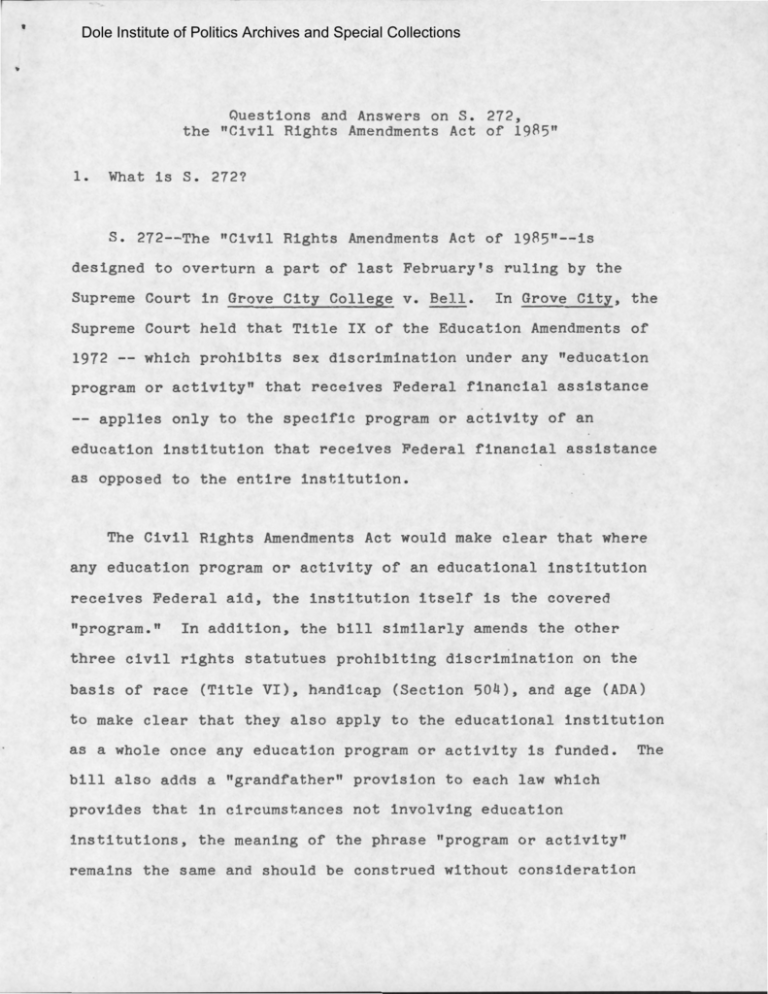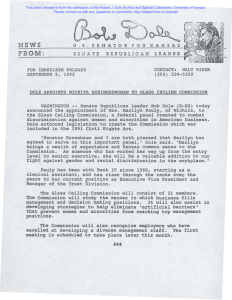Dole Institute of Politics Archives and Special Collections
advertisement

Dole Institute of Politics Archives and Special Collections Questions and Answers on S. 272, the "Civil Rights Amendments Act of 19R5" 1. What is S. 272? S. 272--The "Civil Rights Amendments Act of 19R5"--is designed to overturn a part of last February's ruling by the Supreme Court in Grove City College v. Bell. In Grove City, the Supreme Court held that Title IX of the Education Amendments of 1972 -- which prohibits sex discrimination under any "education program or activity" that receives Federal financial assistance -- applies only to the specific program or activity of an education institution that receives Federal financial assistance as opposed to the entire institution. The Civil Rights Amendments Act would make clear that where any education program or activity of an educational institution receives Federal aid, the institution itself is the covered "program." In addition, the bill similarly amends the other three civil rights statutues prohibiting discrimination on the basis of race (Title VI), h~ndicap (Section 504), and age (ADA) to make clear that they also apply to the educational institution as a whole once any education program or activity is funded. bill also adns a "grandfather" provision to each law which provides that in circumstances not involving education institutions, the meaning of the phrase "program or activity" remains the same and should be construed without consideration The Dole Institute of Politics Archives and Special Collections 2 given to the Grove City decision -- and also to the Supreme Court's earlier North Haven decision, language in which the Supreme Court relied upon in reaching its "program specific" interpretation in Grove City. 2. What was the origin of S. 272? The bill was the result of extensive negotiations which occurred toward the end of the 98th Congress on a proposal introduced by Senator Edward Kennedy entitled the "Civil Rights Act of 1984." The 1984 bill would have amended the four cross- cutting civil rights laws to prohibit discrimination by any "recipient" of Federal funds in lieu of the current language prohibiting discrimination under any Federally funded "program or activity". During hearings, the bill ran into stiff opposition, based on concerns that, as drafted, it would result in a dramatic expansion of existing civil rights coverage. As a consequence, Senator Robert Dole, working with the Administration, initiated negotiations between the proponents and opponents of the Kennedy bill when it came to the floor as an amendment to the Continuing Resolution. Those negotiations produced a compromise proposal which was acceptable to many of the key Senators involved, as well as the Administration. It is that compromise that is now Dole Institute of Politics Archives and Special Collections 3 being offered again by Senator Dole as the "Civil Rights Amendment Act of 1985." 3. What is the primary difference between S. 272 and the "Civil Rights Restoration Act of 19R5"? Both bills overturn the Grove City court's holding that coverage of education institutions is "program specific'' by amending Title IX, as well as Title VI, Section 504, and the ADA. With regard to entities which are not educational institutions, however, the two bills differ significantly. The Civil Rights Restoration Act -- like the Civil Rights Act of 1984 -- specifies all-encompassing coverage principles for any entity which receives Federal funds, regardless of the amount of the aid. Thus, under that bill, education systems, governmental agencies, corporations, partnerships, private organizations, or any other entity would be covered in its entirety, if any component part received Federal money. S. 272, on the other hand, simply provides that in the other areas to which these laws apply, the meaning of "program or activity" remains the same and should be construed without consideration to the Grove City decision. Dole Institute of Politics Archives and Special Collections 4 4. Why does S. 272 deal expressly only with education institutions? Many feel the primary reason for the Senate's failure to pass the Civil Rights Act of 1984 was that it was overly ambitious. Though perceived by many as but a modest piece of legislation designed only to overturn the Supreme Court's programatic interpretation of Title IX in Grove City, in point of fact, it was highly complex legislation which attempted to spell out broad coverage for all the various types of entities that may receive Federal monies. Extended negotiations revealed there was broad based agreement among both the proponents and opponents of the Kennedy bill that civil rights coverage of educational institutions should be institution-wide rather than program specific and that in all other areas of civil rights coverage the reach of the pertinent statutues should remain unaltered by the Grove City decision. A wide difference of opinion existed, however, over what the status quo ante, or "pre-Grove City" coverage, actually was. This bill adopts a pragmatic approach to that dispute by simply making clear, through the use of a ''grandfather" clause, Congress' intent to adhere to pre-Grove City law-- without undertaking to define precisely what that may mean in each and every situation that might arise. To the extent future issues arise with regard to the meaning of the term ''program" they r Dole Institute of Politics Archives and Special Collections should be resolved, as they always have been, with appropriate reference to each law's legislative history, agency interpretation, and, with the two exceptions noted, applicable case law. By its express terms, the bill preserves the jurisdictional scope of the ''program or activity" language as it has existed for over 20 years of Federal civil rights enforcement. 5. Why have some argued that the Civil Rights Amendments Act could codify, instead of overturn, the Grove City case? This argument derives from the definition of "education institution" currently found in Title IX. Under this definition, "administratively separate" units of a college or university can each be considered to be an "education institution." It is the settled understanding of this definition, however, that its "administratively separate" language refers to a school, college, or department of an education institution, admission to which is independent of admission to any other component of the institution. See, 34 C.F.R.Sl06.3. Regulations Implementing Title IX. Department of Education Thus, under this definition, some professional and graduate schools may be considered "administratively separate," and treated as separate "education institutions," (because they may have admissions standards which are not related to admission to any other programs of a Dole Institute of Politics Archives and Special Collections • unviversity) as has always been the case. However, it is the sponsor's understanding of this definition that all undergraduate programs -- including athletics -- have always been treated as a single education institution and thus would be covered in their entirety under the bill. This treatment of graduate and professional schools with independent admission standards as "administratively separate" is consistent with what is understood to have been agency enforcement practice prior to Grove City. (insert House Report) During hearings, however, coverage of graduate and professional schools may be an area Congress will want to evaluate carefully.





